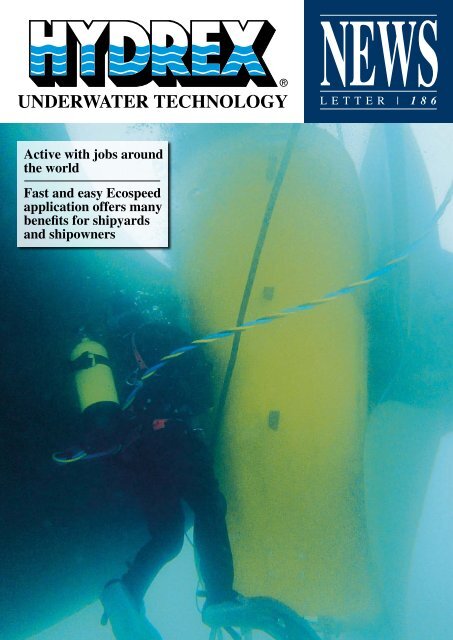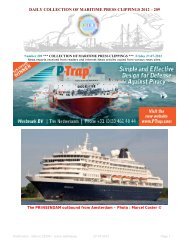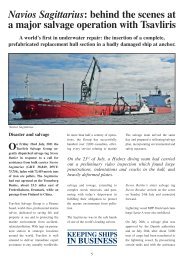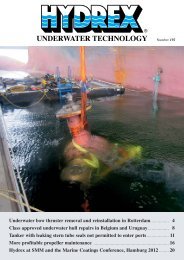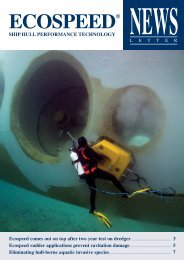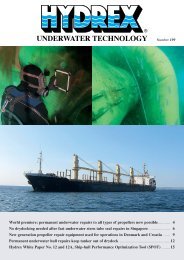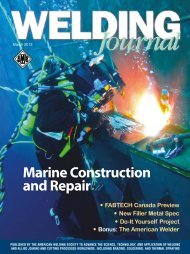Active with jobs around the world Fast and easy Ecospeed ...
Active with jobs around the world Fast and easy Ecospeed ...
Active with jobs around the world Fast and easy Ecospeed ...
Create successful ePaper yourself
Turn your PDF publications into a flip-book with our unique Google optimized e-Paper software.
<strong>Active</strong> <strong>with</strong> <strong>jobs</strong> <strong>around</strong><br />
<strong>the</strong> <strong>world</strong><br />
<strong>Fast</strong> <strong>and</strong> <strong>easy</strong> <strong>Ecospeed</strong><br />
application offers many<br />
benefits for shipyards<br />
<strong>and</strong> shipowners<br />
NEWS<br />
LETTER | 186
Contents<br />
Page 3 - 9<br />
Three repairs carried out on<br />
general cargo vessel at<br />
anchorage in Gabon<br />
On-site propeller<br />
cropping in Ghent<br />
Underwater stern tube seal<br />
replacement on general<br />
cargo vessel in Las Palmas<br />
Page 12 - 18<br />
<strong>Fast</strong> <strong>and</strong> <strong>easy</strong> <strong>Ecospeed</strong><br />
application offers many benefits<br />
for shipyards <strong>and</strong> shipowners<br />
KEEPING SHIPS<br />
IN BUSINESS<br />
KEEPING SHIPS<br />
IN BUSINESS<br />
ISO 9001<br />
certified<br />
Underwater services <strong>and</strong><br />
technology approved by:<br />
Supreme Rudder<br />
Protection<br />
<strong>Ecospeed</strong> gives a very thorough<br />
<strong>and</strong> lasting defense<br />
against cavitation <strong>and</strong> corrosion<br />
damage for a ship hull’s entire<br />
service life.<br />
The coating equally provides <strong>the</strong><br />
rudder <strong>with</strong> an impenetrable pro-<br />
tective layer while its flexibility<br />
enables absorption of <strong>the</strong> forces<br />
that are produced by cavitation.<br />
This prevents <strong>the</strong> damage normally<br />
caused by this phenomenon.<br />
Without proper protection against<br />
cavitation <strong>and</strong> <strong>the</strong> resulting erosion<br />
<strong>and</strong> corrosion damage, <strong>the</strong><br />
Belgian headquarters<br />
Phone: + 32 3 213 5318<br />
Fax: + 32 3 213 5321<br />
info@ecospeed.be<br />
2<br />
financial consequences can be<br />
severe.<br />
By removing <strong>the</strong> existing paint<br />
layers <strong>and</strong> applying <strong>Ecospeed</strong><br />
on <strong>the</strong> rudder we can break <strong>the</strong><br />
never ending cycle of painting,<br />
suffering damage, having to per-<br />
form extensive repairs in drydock<br />
followed by a full repainting,<br />
again <strong>and</strong> again.<br />
With an <strong>Ecospeed</strong> application no<br />
full repaint will be needed during<br />
drydocking. <strong>Ecospeed</strong> is guaranteed<br />
for ten years. At <strong>the</strong> most,<br />
minor touch-ups will be required.<br />
US Office<br />
Phone: + 1 727 443 3900<br />
Fax: + 1 727 443 3990<br />
info@ecospeed.us<br />
www.ecospeed.be
Three repairs carried out on general<br />
cargo vessel at anchorage in Gabon<br />
Hydrex diver/technicians carried<br />
out three separate repairs on<br />
a 118-meter general cargo vessel<br />
while <strong>the</strong> ship was at anchorage<br />
off <strong>the</strong> coast of Port Gentil, Gabon.<br />
These on-site repairs allowed <strong>the</strong><br />
customer to save precious time<br />
<strong>and</strong> money.<br />
The entire operation was supervised<br />
<strong>and</strong> coordinated by <strong>the</strong> Hydrex team<br />
leader from inside a monitoring<br />
station.<br />
Bulbous bow repair<br />
A detailed inspection of both <strong>the</strong><br />
outside <strong>and</strong> inside of <strong>the</strong> bulbous<br />
bow revealed that <strong>the</strong> entire area<br />
had been damaged. The bottom<br />
of <strong>the</strong> bow was heavily indented<br />
<strong>Active</strong> <strong>with</strong> <strong>jobs</strong><br />
<strong>around</strong> <strong>the</strong> <strong>world</strong><br />
(see pictures on <strong>the</strong> right). This<br />
had caused serious deformation<br />
of <strong>the</strong> structural framework in <strong>the</strong><br />
forepeak of <strong>the</strong> vessel (see pictures<br />
below). There were also several<br />
cracks <strong>and</strong> small holes in <strong>the</strong> hull<br />
plating.<br />
The Hydrex team installed 14 larger<br />
doubler plates (see pictures at <strong>the</strong> top<br />
of page 4), as well as many smaller<br />
ones to close off <strong>the</strong> damaged area<br />
from <strong>the</strong> rest of <strong>the</strong> vessel <strong>and</strong> prevent<br />
leaks. Three additional frames<br />
were also installed to reinforce <strong>the</strong><br />
bulkhead <strong>and</strong> to make sure that<br />
<strong>the</strong> vessel could sail safely. Finally<br />
crack arrests were drilled to prevent<br />
<strong>the</strong> cracks from spreading<br />
any fur<strong>the</strong>r.<br />
There were serious deformations of <strong>the</strong> structural framework in <strong>the</strong> forepeak.<br />
3<br />
The bottom of <strong>the</strong> bulbous bow was<br />
heavily indented.
The Hydrex team installed 14 larger doubler frames, as well as many smaller ones.<br />
The Hydrex technicians cut away <strong>the</strong> old plating <strong>around</strong> <strong>the</strong> brackets on <strong>the</strong> port side of one of <strong>the</strong> guiding frames in <strong>the</strong><br />
cargo hold.<br />
The worn tubes (left) were also removed <strong>and</strong> replaced <strong>with</strong> new ones (right).<br />
4
The inserts in <strong>the</strong> cargo hold bottom<br />
plating were positioned <strong>and</strong> <strong>the</strong>n secured<br />
<strong>with</strong> a full penetration weld.<br />
Insert repairs in bottom<br />
plating<br />
To repair holes in <strong>the</strong> bottom plating<br />
of <strong>the</strong> cargo hold, <strong>the</strong> Hydrex diver/<br />
technicians installed two insert<br />
plates, measuring 600 x 600 mm <strong>and</strong><br />
500 x 450 mm (see pictures in <strong>the</strong><br />
top left corner of this page). After<br />
<strong>the</strong>y had cut away <strong>the</strong> damaged<br />
areas <strong>the</strong>y prepared <strong>the</strong> edges of<br />
both holes. Next <strong>the</strong> new inserts<br />
were positioned <strong>and</strong> kept in place<br />
<strong>with</strong> screw docks. A full penetration<br />
weld was <strong>the</strong>n used to secure <strong>the</strong><br />
plates, finishing <strong>the</strong> second part of<br />
<strong>the</strong> operation.<br />
Installation of new brackets<br />
on frame in cargo hold<br />
Simultaneously <strong>with</strong> <strong>the</strong> o<strong>the</strong>r<br />
two repairs, <strong>the</strong> Hydrex team also<br />
replaced plating of <strong>the</strong> damaged<br />
port side brackets of one of <strong>the</strong> large<br />
container guiding frames in <strong>the</strong> cargo<br />
hold (see pictures in <strong>the</strong> middle row<br />
of page 4). Pins are pushed through<br />
this plating <strong>and</strong> into tubes in <strong>the</strong><br />
hold wall to secure <strong>the</strong> frames. This<br />
allows <strong>the</strong> crew to reposition <strong>the</strong><br />
frames or remove <strong>the</strong>m according<br />
to <strong>the</strong> requirements of <strong>the</strong> cargo that<br />
is transported. The Hydrex techni-<br />
Hydrex installed two inserts in <strong>the</strong> cargo hold <strong>and</strong> several new brackets on one<br />
of <strong>the</strong> frames.<br />
New pins were also fabricated to fit inside <strong>the</strong> new plating <strong>and</strong> tubes behind it.<br />
5<br />
cians cut away <strong>the</strong> old plating on<br />
<strong>the</strong> frames as well as on <strong>the</strong> hold<br />
wall <strong>and</strong> installed new plating <strong>with</strong><br />
full penetration welds. They also<br />
replaced <strong>the</strong> old worn tubes in <strong>the</strong><br />
cargo hold wall <strong>and</strong> <strong>the</strong> securing<br />
pins <strong>with</strong> new ones (see pictures on<br />
<strong>the</strong> bottom row of page 4 <strong>and</strong> in <strong>the</strong><br />
top right corner of this page).<br />
Carrying out <strong>the</strong>se three repairs during<br />
one operation while <strong>the</strong> vessel<br />
was at anchorage illustrates <strong>the</strong> flexi-<br />
bility <strong>and</strong> professionalism of Hydrex<br />
<strong>and</strong> its staff members. The company’s<br />
goal has always been to keep a vessel<br />
out of drydock as much as possible<br />
<strong>and</strong> to carry out needed repairs or<br />
maintenance <strong>with</strong> <strong>the</strong> least possible<br />
interruption to <strong>the</strong> sailing schedule.<br />
With no drydock close by, this was<br />
extremely important for this customer.<br />
The Hydrex technical department<br />
has <strong>the</strong> know-how <strong>and</strong> experience to<br />
create tailor-made solutions for <strong>the</strong><br />
specific problems encountered by a<br />
shipowner, while <strong>the</strong> diver/technicians<br />
have been trained to perform<br />
<strong>the</strong>se operations in <strong>the</strong> shortest possible<br />
time frame <strong>and</strong> <strong>with</strong>out losing<br />
<strong>the</strong> quality Hydrex is known for.<br />
KEEPING SHIPS<br />
IN BUSINESS<br />
KEEPING SHIPS
When all four propeller<br />
blades of a 100-meter general<br />
cargo vessel were severely<br />
bent, a repair was required by<br />
<strong>the</strong> classification society. Hydrex<br />
<strong>the</strong>refore performed a detailed<br />
video inspection, followed by a<br />
repair while <strong>the</strong> vessel was ber<strong>the</strong>d<br />
in Ghent, Belgium.<br />
To make a full assessment of <strong>the</strong><br />
damage, <strong>the</strong> diver/technician team<br />
first performed a detailed underwater<br />
inspection of <strong>the</strong> blades. This revealed<br />
that one blade was bent over<br />
an angle of 15° while <strong>the</strong> o<strong>the</strong>r<br />
three were bent over an angle of<br />
On-site propeller<br />
cropping in Ghent<br />
Permanent rudder repairs now<br />
possible <strong>with</strong>out drydocking<br />
Hydrex has developed an<br />
entirely new method enabling<br />
permanent repairs of rudders<br />
<strong>with</strong>out drydocking <strong>the</strong> ship. Permanent<br />
repairs were hi<strong>the</strong>rto not<br />
possible <strong>and</strong> ships had to drydock<br />
in case a major defect was found.<br />
The newly designed equipment is<br />
lightweight <strong>and</strong> can be mobilized<br />
very rapidly in our special flight<br />
containers. Therefore this new<br />
service is now available <strong>world</strong>wide.<br />
Major defects on rudders very often<br />
cause unscheduled drydocking of<br />
ships. The new method designed by<br />
our technical department allows<br />
engineers, welders <strong>and</strong> inspectors to<br />
perform <strong>the</strong>ir tasks in dry conditions.<br />
Class approved permanent repairs<br />
in-situ, <strong>with</strong>out moving <strong>the</strong> ship, are<br />
now possible <strong>and</strong> commercial operations<br />
can continue. Steel repairs <strong>and</strong><br />
replacements can be performed <strong>and</strong><br />
pintle <strong>and</strong> bushing defects can be<br />
solved <strong>with</strong>out <strong>the</strong> loss of time <strong>and</strong><br />
money associated <strong>with</strong> drydocking.<br />
The equipment can be mobilized <strong>with</strong>in<br />
hours to any port in <strong>the</strong> <strong>world</strong> <strong>and</strong> is<br />
available for rapid mobilization from<br />
<strong>the</strong> Hydrex headquarters in Antwerp.<br />
6<br />
The Hydrex team prepares for <strong>the</strong> propeller blade cropping.
A video inspection revealed severe damage to <strong>the</strong> propeller blades. Beside being bent, <strong>the</strong> propeller blades<br />
were also missing large chunks.<br />
Cropping <strong>the</strong> blades restored <strong>the</strong> propeller’s balance.<br />
All four blades of <strong>the</strong> propeller were cropped in <strong>the</strong> exact same manner.<br />
7<br />
90°. Because <strong>the</strong> damage was too<br />
extensive, straightening <strong>the</strong>se last<br />
three blades was not an option. To<br />
keep <strong>the</strong> balance of <strong>the</strong> propeller, it<br />
was decided to crop all four blades at<br />
<strong>the</strong> exact same position.<br />
The information acquired during<br />
<strong>the</strong> inspection was <strong>the</strong>n used to<br />
determine <strong>the</strong> correct measurements<br />
needed for <strong>the</strong> cropping. The area<br />
to be cropped was marked out on<br />
<strong>the</strong> four blades <strong>and</strong> verified. The<br />
team <strong>the</strong>n cropped <strong>the</strong> blades one by<br />
one <strong>and</strong> ground <strong>the</strong>ir edges to give<br />
<strong>the</strong>m <strong>the</strong> correct radius. When <strong>the</strong><br />
cropping was complete, <strong>the</strong> Hydrex<br />
technicians polished <strong>the</strong> blades to<br />
make sure that any remaining loss of<br />
efficiency would be minimal.<br />
This restored <strong>the</strong> propeller’s balance<br />
<strong>and</strong> brought its performance as close<br />
to its optimum performance as could<br />
be achieved. The job was completed<br />
on-site, saving <strong>the</strong> time, expense <strong>and</strong><br />
extra work of drydocking <strong>the</strong> vessel.<br />
KEEPING SHIPS<br />
IN BUSINESS<br />
KEEPING SHIPS
Underwater stern tube seal replacement<br />
on general cargo vessel in Las Palmas<br />
Last month Hydrex mobilized<br />
a diver/technician team to a<br />
145-meter general cargo vessel in<br />
Las Palmas, Spain when oil was<br />
leaking from <strong>the</strong> stern tube seal<br />
assembly of <strong>the</strong> ship. The team<br />
used <strong>the</strong> Hydrex flexible mobock<br />
technique to create a dry working<br />
environment <strong>around</strong> <strong>the</strong> assembly<br />
<strong>and</strong> replaced three damaged stern<br />
tube seals on-site, in drydock-like<br />
conditions.<br />
The operation started <strong>with</strong> a thorough<br />
underwater inspection of <strong>the</strong> stern<br />
tube seal assembly. This revealed that<br />
<strong>the</strong> rope guard was missing. The team<br />
also found a rope entangled <strong>around</strong><br />
<strong>the</strong> assembly, damaging <strong>the</strong> stern tube<br />
seals <strong>and</strong> causing <strong>the</strong> oil leak.<br />
The Hydrex flexible mobdock is used to create a dry working environment underwater.<br />
A rope was tangled <strong>around</strong> <strong>the</strong> stern tube seal assemby, damaging <strong>the</strong> seals.<br />
8<br />
Two of <strong>the</strong> split rings were <strong>the</strong>n<br />
disconnected <strong>and</strong> brought to <strong>the</strong><br />
surface to be cleaned. Next <strong>the</strong> diver/<br />
technicians installed <strong>the</strong> Hydrex<br />
flexible mobdock <strong>around</strong> <strong>the</strong> stern<br />
tube seal assembly. This allowed<br />
<strong>the</strong> team to work on <strong>the</strong> assembly<br />
in dry conditions, a necessity for<br />
permanent stern tube seal repairs.<br />
The divers <strong>the</strong>n replaced <strong>the</strong> three<br />
seals one by one <strong>with</strong> new ones.<br />
After <strong>the</strong>se were bonded, <strong>the</strong> team<br />
reassembled <strong>the</strong> entire unit <strong>and</strong><br />
pressure tests were carried out <strong>with</strong><br />
positive results. The flexible<br />
mobdock was <strong>the</strong>n removed, concluding<br />
<strong>the</strong> repair. Because a new<br />
rope guard could not be delivered<br />
on time, <strong>the</strong> ship superintendent<br />
decided to have it delivered to <strong>the</strong><br />
vessel’s next stop in Philadelphia,<br />
U.S.A.
Hydrex diver/technician working inside <strong>the</strong> flexible mobdock.<br />
After opening up <strong>the</strong> stern tube seal assembly, <strong>the</strong> divers could replace <strong>the</strong> seals.<br />
In order to provide <strong>the</strong> customer<br />
<strong>with</strong> <strong>the</strong> fastest possible response,<br />
flexibility was essential throughout<br />
<strong>the</strong> entire operation. Every day<br />
a ship has to go off hire causes a<br />
substantial loss of money. The team<br />
<strong>the</strong>refore worked in shifts to perform<br />
<strong>the</strong> stern tube seal repair <strong>with</strong>in<br />
<strong>the</strong> shortest possible time frame.<br />
Keeping his vessel out of drydock<br />
saved <strong>the</strong> customer a great deal of<br />
time <strong>and</strong> money.<br />
KEEPING SHIPS<br />
IN BUSINESS<br />
9 KEEPING SHIPS<br />
On-site bow<br />
thruster<br />
repairs<br />
The Hydrex lightweight flexible<br />
mobdocks are designed<br />
to be easily transported <strong>around</strong><br />
<strong>the</strong> <strong>world</strong> <strong>and</strong> are used to close<br />
off <strong>the</strong> thruster tunnel on both<br />
sides, allowing divers to perform<br />
repairs <strong>and</strong> o<strong>the</strong>r operations in<br />
a dry environment <strong>around</strong> <strong>the</strong><br />
bow thruster unit.<br />
This technique enables <strong>the</strong>m to<br />
reinstall <strong>the</strong> propeller blades of an<br />
overhauled thruster inside <strong>the</strong><br />
thruster tunnel after <strong>the</strong> unit has<br />
been secured or replace <strong>the</strong> blades<br />
or seals <strong>and</strong> perform repair work<br />
on a specific part <strong>with</strong>out removing<br />
<strong>the</strong> unit.<br />
Since <strong>the</strong> development of this<br />
flexible mobdock technique, nu-<br />
merous thruster repairs have been<br />
carried out by Hydrex diver/<br />
technicians <strong>around</strong> <strong>the</strong> <strong>world</strong>.<br />
There is no need to send <strong>the</strong><br />
vessel to drydock as all operations<br />
can be carried out in port or while<br />
<strong>the</strong> vessel is stationary at sea.<br />
Normal commercial activities<br />
can <strong>the</strong>refore continue <strong>with</strong>out<br />
disruption.<br />
Phone: + 32 3 213 5300 (24/7)<br />
Fax: + 32 3 213 5321<br />
hydrex@hydrex.be<br />
www.hydrex.be
<strong>Fast</strong> <strong>and</strong> <strong>easy</strong> <strong>Ecospeed</strong><br />
application offers many benefits<br />
for shipyards <strong>and</strong> shipowners<br />
Alot has been written on <strong>the</strong><br />
advantages of <strong>the</strong> <strong>Ecospeed</strong><br />
underwater ship hull coating<br />
system. The coating offers many<br />
long term benefits to shipowners,<br />
ship managers <strong>and</strong> operators <strong>and</strong><br />
this both from an economical as<br />
well as ecological point of view.<br />
The more practical <strong>and</strong> direct<br />
advantages of <strong>Ecospeed</strong> have been<br />
documented much less. In this<br />
article we take a closer look at how<br />
applying <strong>Ecospeed</strong> to a vessel can<br />
save much worry, time <strong>and</strong> hassle<br />
for superintendents <strong>and</strong> shipyards<br />
during drydockings, as well as<br />
save expenses for <strong>the</strong> owner.<br />
Despite some supplier claims to <strong>the</strong><br />
contrary, almost no underwater hull<br />
coating provides for <strong>the</strong> most basic<br />
objective which is to protect <strong>the</strong> steel<br />
from corrosion <strong>and</strong> prevent <strong>the</strong> hull<br />
from ‘roughening’ <strong>with</strong> age. When<br />
ships come into drydock, it is not<br />
uncommon to observe delamination<br />
of multiple paint layers. There is<br />
often also evidence of corrosion<br />
<strong>and</strong> hull roughening. Repairs of <strong>the</strong><br />
underwater hull coating systems<br />
With <strong>Ecospeed</strong> no full repaint will be necessary during future drydockings.<br />
12<br />
An <strong>Ecospeed</strong> application is adapted to a ship yard’s schedule.<br />
greater than 50 percent of <strong>the</strong><br />
underwater area, <strong>and</strong> up to <strong>and</strong><br />
including complete replacement of<br />
<strong>the</strong> hull coating, are not uncommon.<br />
This results in significant cost to<br />
<strong>the</strong> shipowners, both in terms of<br />
materials <strong>and</strong> labor, <strong>and</strong> in fuel costs<br />
due to <strong>the</strong> roughened conditions<br />
of <strong>the</strong> hulls <strong>and</strong> ultimately also in<br />
frequent required drydocking-time.<br />
So it’s <strong>easy</strong> to see that <strong>the</strong> total<br />
ownership cost (TOC) of a vessel<br />
would drop for a ship operating <strong>with</strong><br />
a hull that is effectively protected.<br />
<strong>Ecospeed</strong> is an extremely hard<br />
coating <strong>with</strong> optimized hydrodynamics<br />
that can easily be maintained<br />
in service. This has a huge potential<br />
for reducing total cost of ownership<br />
of <strong>the</strong> vessel. When ships come out of<br />
<strong>the</strong> water after lengthy periods, <strong>the</strong>re<br />
is no delamination of <strong>the</strong> coating<br />
from <strong>the</strong> hull, <strong>the</strong>re are no paint<br />
blisters that would be indicative of
<strong>Ecospeed</strong> also protects areas that are more prone to cavitation damage, like<br />
rudders.<br />
anti-corrosive failure, <strong>and</strong> <strong>the</strong> overall<br />
hull is still smooth. There are<br />
also <strong>the</strong> environmentally friendly<br />
aspects of <strong>the</strong> product. Studies done<br />
in <strong>the</strong> EU, by <strong>the</strong> Ne<strong>the</strong>rl<strong>and</strong>s in<br />
particular, have determined that in-<br />
water cleaning of <strong>Ecospeed</strong> pro-<br />
duces no materials that are toxic<br />
to <strong>the</strong> marine environment.<br />
High quality application–<br />
<strong>the</strong> secret of long term<br />
durability<br />
The reason for <strong>the</strong> pristine condition<br />
of <strong>the</strong> <strong>Ecospeed</strong> coating after several<br />
service years is very simple according<br />
to Mr. Gunnar Ackx, managing<br />
director of SCICON Worldwide,<br />
After surface preparation, <strong>Ecospeed</strong> is applied in only two, identical, coats.<br />
13<br />
an independent coating inspection<br />
<strong>and</strong> consulting company. SCICON<br />
provides clients <strong>with</strong> various in-<br />
spection <strong>and</strong> consulting services in<br />
<strong>the</strong> field of corrosion protection of<br />
steel, concrete, <strong>and</strong> o<strong>the</strong>r surfaces in<br />
just about any industry. SCICON’s<br />
main focus is Europe, but <strong>the</strong>y have<br />
clients in many countries <strong>around</strong> <strong>the</strong><br />
<strong>world</strong>.<br />
As a coating inspector <strong>and</strong> consultant,<br />
Gunnar Ackx has had <strong>the</strong><br />
opportunity to inspect <strong>and</strong> assist<br />
<strong>the</strong> very first <strong>Ecospeed</strong> application,<br />
almost ten years ago. “When I first<br />
saw <strong>the</strong> ship come out of <strong>the</strong> water<br />
prior to <strong>the</strong> <strong>Ecospeed</strong> application<br />
<strong>and</strong> noticed how banged up <strong>the</strong> hull<br />
was, my first reaction was: ‘This<br />
is never going to work.’ But that<br />
job certainly did prove me wrong.<br />
I have been amazed at <strong>Ecospeed</strong>’s<br />
performance ever since.”<br />
To Mr. Ackx it is clear that <strong>the</strong> high<br />
quality of an <strong>Ecospeed</strong> application is<br />
key to <strong>the</strong> excellent results obtained<br />
<strong>with</strong> <strong>the</strong> coating. “An SSPC-SP10 /<br />
ISO Sa 2.5 blast cleanliness is still<br />
<strong>the</strong> best value for money in <strong>the</strong><br />
corrosion protection business, irrespective<br />
of <strong>the</strong> type of coating<br />
project,” he says. “We always advocate<br />
that surface preparation is <strong>the</strong><br />
foundation of any coating system. So<br />
as soon as you start tampering <strong>with</strong><br />
<strong>the</strong> quality of <strong>the</strong> surface preparation,<br />
you will tamper <strong>with</strong> <strong>the</strong> total<br />
quality, hence service life of ANY
An <strong>Ecospeed</strong> coating inspector is present <strong>and</strong> available<br />
for <strong>the</strong> painters on every job.<br />
coating. A proverb that we often use<br />
during our inspection assignments<br />
is: ‘If you fail to prepare, prepare<br />
to fail’ which says a lot about <strong>the</strong><br />
above. Of course an SSPC-SP10 /<br />
ISO Sa 2.5 blast cleanliness is not<br />
<strong>the</strong> cheapest of surface preparations<br />
you can get <strong>and</strong> can sometimes be<br />
somewhat challenging in a drydocking<br />
situation. However, you<br />
will only have to do it once! Because<br />
once you have applied <strong>the</strong> 2-coat<br />
<strong>Ecospeed</strong> hull coating, you’ll never<br />
have to reblast again, throughout <strong>the</strong><br />
entire service life of <strong>the</strong> ship.”<br />
The importance of a quality st<strong>and</strong>ard<br />
during application cannot be<br />
overestimated. <strong>Ecospeed</strong>’s manu-<br />
facturers have access to very ex-<br />
14<br />
tensive research in this field <strong>and</strong><br />
especially regarding <strong>the</strong> decay or<br />
degradation of o<strong>the</strong>r paint systems<br />
over drydocking intervals. Most of<br />
<strong>the</strong> time <strong>the</strong> effect of this degradation<br />
of <strong>the</strong> paint system <strong>and</strong> <strong>the</strong> build up<br />
of paint layers on <strong>the</strong> fuel efficiency<br />
of <strong>the</strong> ship has been largely underestimated.<br />
Ideally, during a second<br />
special survey of a ship in drydock<br />
Class Accepted underwater stern<br />
tube seal repairs under warranty<br />
Using our flexible mobdock<br />
method to create a dry underwater<br />
environment, we have carried<br />
out stern tube seal repairs <strong>and</strong><br />
replacements underwater for some<br />
years now in cooperation <strong>with</strong> top<br />
specialist suppliers.<br />
This technology brings drydock<br />
conditions to <strong>the</strong> ship ra<strong>the</strong>r than<br />
having to take <strong>the</strong> ship to drydock,<br />
saving a considerable amount of<br />
time <strong>and</strong> money in doing so.<br />
This class accepted method is<br />
performed by our diving teams under<br />
our warranty. It can be used while <strong>the</strong><br />
ship is carrying out its usual cargo or<br />
o<strong>the</strong>r commercial operations in port.<br />
Visit <strong>the</strong> special stern tube seal repair<br />
section on our website for more<br />
information <strong>and</strong> examples of <strong>the</strong><br />
many seal repairs we have performed<br />
in recent years.<br />
www.hydrex.be<br />
The second (final) coat can be applied <strong>with</strong>in a couple of<br />
hours or after a few weeks or even months.
By removing <strong>the</strong> existing paint layers <strong>and</strong> applying<br />
<strong>Ecospeed</strong> on rudders we can break <strong>the</strong> never ending cycle<br />
of painting <strong>and</strong> repainting.<br />
<strong>Ecospeed</strong>’s flexibility enables absorption<br />
of <strong>the</strong> forces that are produced<br />
by cavitation, preventing damage.<br />
<strong>the</strong>re are very substantial benefits<br />
in stripping away all <strong>the</strong> old paint;<br />
immediate fuel savings of up to<br />
20-30% are very realistic numbers.<br />
When <strong>the</strong> <strong>Ecospeed</strong> coating is<br />
applied correctly this build up of<br />
paint layers is ended forever. Any<br />
paint system is only as good as it<br />
is applied. For this reason at least<br />
one <strong>Ecospeed</strong> coating inspector is<br />
present <strong>and</strong> available for <strong>the</strong> painters<br />
on every job. This is to check <strong>the</strong><br />
conditions during <strong>the</strong> application<br />
process, but also to work closely<br />
<strong>with</strong> <strong>the</strong>m to help ensure a very <strong>easy</strong><br />
<strong>and</strong> smooth application. Because <strong>the</strong><br />
inspectors are closely involved <strong>with</strong><br />
<strong>the</strong> application, <strong>the</strong>y know exactly<br />
what has happened during <strong>the</strong><br />
coating process. This allows <strong>the</strong>m<br />
to approve <strong>the</strong> 10 year warranty that<br />
comes <strong>with</strong> an <strong>Ecospeed</strong> application.<br />
Hydrex works <strong>with</strong> its own team<br />
of highly certified, highly qualified<br />
coating inspectors. These inspectors<br />
have been working <strong>with</strong> <strong>Ecospeed</strong><br />
for many years. They are not only<br />
familiar <strong>with</strong> <strong>Ecospeed</strong>, but <strong>with</strong><br />
a wide variety of o<strong>the</strong>r coating<br />
systems. They are also very important<br />
in terms of cooperation<br />
<strong>with</strong> <strong>the</strong> shipyard, making sure that<br />
<strong>the</strong> product is applied according<br />
to <strong>the</strong> required st<strong>and</strong>ards <strong>and</strong> thus<br />
15<br />
Shipowners will not have to do any repainting beyond<br />
minor touch-ups during future drydockings.<br />
The coating can also be used to protect thruster tunnels against cavitation <strong>and</strong><br />
corrosion damage.<br />
that <strong>the</strong> results will be <strong>the</strong>re for <strong>the</strong><br />
shipowner for <strong>the</strong> next ten years <strong>and</strong><br />
beyond.<br />
Cost of application <strong>and</strong><br />
maintenance in relation to<br />
total ownership cost<br />
If an owner really has problems <strong>with</strong><br />
<strong>the</strong> cost of such surface preparation,<br />
Gunnar usually sits down <strong>with</strong> <strong>the</strong>m<br />
to do <strong>the</strong> math on <strong>the</strong> alternatives.<br />
“If you reapply 2, 3 to 4 layers of<br />
antifouling coating on <strong>the</strong> entire<br />
hull <strong>and</strong> are re-doing <strong>the</strong> above<br />
every 3 to 5 years, you inevitably<br />
come to a point where <strong>the</strong>re are too<br />
many layers of coating on <strong>the</strong> ship’s
hull.” Gunnar <strong>the</strong>n tells <strong>the</strong>m that,<br />
“This will degrade <strong>the</strong> quality of <strong>the</strong><br />
coating even more easily <strong>and</strong> rapidly<br />
because of <strong>the</strong> internal stresses being<br />
built up in <strong>the</strong> coating, resulting in a<br />
required full reblast, probably every<br />
10 years or so.” He recalls a recent<br />
drydocking of a large cruise vessel<br />
where some 2.0 to 2.5 mm thick<br />
old coating system was removed<br />
completely. “It probably consisted<br />
of up to 15 or more layers, which<br />
were continuously flaking off here<br />
<strong>and</strong> <strong>the</strong>re <strong>and</strong> were patch-repaired<br />
for a number of years. If you make<br />
such a calculation over, say, a 25year<br />
service life <strong>and</strong> compare that<br />
<strong>with</strong> <strong>the</strong> initial cost of <strong>the</strong> <strong>Ecospeed</strong><br />
application combined <strong>with</strong> <strong>the</strong> very<br />
minimal maintenance it requires, it<br />
doesn’t take a rocket scientist to figure<br />
out which is more economical. And<br />
that is not even taking into account<br />
possible reduced drydocking times<br />
<strong>and</strong> fuel savings because of some<br />
o<strong>the</strong>r characteristics of <strong>the</strong> <strong>Ecospeed</strong><br />
hull coating.”<br />
Flexible <strong>and</strong> <strong>easy</strong> to learn<br />
application process<br />
The high st<strong>and</strong>ard that Hydrex<br />
dem<strong>and</strong>s for an <strong>Ecospeed</strong> application<br />
does not mean that learning to work<br />
<strong>with</strong> <strong>the</strong> coating is a difficult process<br />
nor that <strong>the</strong> application itself is hard<br />
to schedule or carry out.<br />
Applying <strong>Ecospeed</strong> is quite straightforward.<br />
Common sense needs to<br />
be used <strong>with</strong> every single coating<br />
application. There are stricter guide-<br />
lines on <strong>the</strong> pot life <strong>and</strong> <strong>the</strong> thorough<br />
cleaning of equipment, but in general<br />
it paints like any o<strong>the</strong>r paint. Most<br />
applicators are quite familiar <strong>with</strong><br />
hard solid paints <strong>and</strong> <strong>the</strong>y know <strong>the</strong><br />
tricks of <strong>the</strong> trade. Mr. Ackx confirms<br />
this. “In <strong>the</strong> last couple of years our<br />
inspectors have probably inspected<br />
close to 125 <strong>Ecospeed</strong> <strong>jobs</strong> <strong>and</strong><br />
every time <strong>the</strong> specifications were<br />
followed by <strong>the</strong> coating contractor,<br />
<strong>the</strong> application went very well <strong>and</strong><br />
smoothly.”<br />
The <strong>Ecospeed</strong> coating also offers a<br />
tremendous flexibility to <strong>the</strong> shipyard.<br />
The minimum overcoating<br />
time is three to four hours, which<br />
means that, for smaller surfaces<br />
such as rudders, propellers or bow<br />
thrusters, <strong>the</strong> two coats required<br />
can often be applied in one single<br />
day. “If blasting is done overnight<br />
<strong>and</strong> approved during a morning<br />
inspection, <strong>the</strong> object to be coated<br />
can be ready by nightfall.” Mr. Ackx<br />
tell us. “As <strong>the</strong> coating inspector,<br />
you rarely come in at <strong>the</strong> exact right<br />
time when <strong>the</strong> yard is ready to start<br />
blasting <strong>and</strong>/or coating. Especially<br />
during drydockings, <strong>the</strong>re is a lot<br />
more going on than just <strong>the</strong> hull<br />
16<br />
coating, which can easily interfere<br />
<strong>with</strong> <strong>the</strong> planning of your project.<br />
Because of <strong>the</strong> fact that <strong>Ecospeed</strong><br />
consists of only 2 coats <strong>and</strong> has<br />
quick <strong>and</strong> flexible overcoating<br />
times, this often allows <strong>the</strong> <strong>Ecospeed</strong><br />
job to be scheduled <strong>around</strong> o<strong>the</strong>r<br />
work taking place, resulting in<br />
minimal interference among various<br />
activities.” He recalls a drydocking<br />
in Malaysia, where <strong>the</strong> wea<strong>the</strong>r is<br />
notoriously unpredictable: “They<br />
were applying <strong>Ecospeed</strong> onto <strong>the</strong><br />
vertical sides of a ship <strong>with</strong> steel<br />
temperatures up to 39 °C because<br />
of <strong>the</strong> sun when five minutes later a<br />
thunderstorm passed by <strong>and</strong> chased<br />
everyone underneath <strong>the</strong> ship. After<br />
<strong>the</strong> storm had passed, I expected<br />
<strong>the</strong> coating to have sustained quite<br />
some rain impact damage, but to<br />
my surprise <strong>the</strong> coating was curing<br />
so rapidly on <strong>the</strong> hot steel surface<br />
A two coat application is always going to be quicker, cheaper <strong>and</strong> more flexible<br />
compared to o<strong>the</strong>r systems.
The high st<strong>and</strong>ard that Hydrex dem<strong>and</strong>s for an <strong>Ecospeed</strong> application does not<br />
mean that learning to work <strong>with</strong> <strong>the</strong> coating is a difficult process.<br />
that absolutely no rain damage was<br />
visible at all. There were also no<br />
signs of ‘solvent-entrapment’ whatsoever,<br />
which sometimes occurs<br />
when solvent based coatings are<br />
applied onto too hot of a surface.<br />
Twenty minutes later <strong>the</strong> hull had<br />
dried up <strong>and</strong> we could continue<br />
spraying again.”<br />
<strong>Ecospeed</strong> only requires two layers<br />
of 500 µm each. This is also a major<br />
advantage compared <strong>with</strong> o<strong>the</strong>r hull<br />
coatings. “Whe<strong>the</strong>r you’re looking at<br />
classic antifouling coating systems<br />
which easily have five or more<br />
coating layers to be applied, or when<br />
comparing <strong>Ecospeed</strong> to some of <strong>the</strong><br />
newer silicone based hull coatings,<br />
which also consist of four to five<br />
layers of coating to be applied, a<br />
two coat application is always going<br />
to be quicker, cheaper <strong>and</strong> more<br />
flexible,” Gunnar Ackx explains.<br />
The coating schedule can be adapted<br />
to that of <strong>the</strong> yard <strong>and</strong> it does not<br />
have to be <strong>the</strong> o<strong>the</strong>r way <strong>around</strong>. A<br />
traditional paint application schedule<br />
is defined by surface preparation <strong>and</strong><br />
by <strong>the</strong> wea<strong>the</strong>r conditions, which are<br />
difficult to predict. In this respect <strong>the</strong><br />
application of <strong>Ecospeed</strong> is easier to<br />
adapt to <strong>the</strong> application windows that<br />
become available. You can apply <strong>the</strong><br />
coating quite rapidly on a prepared<br />
surface <strong>and</strong> <strong>the</strong> possible overcoat<br />
time ranges from three hours to very<br />
extended periods of time. Depending<br />
on whatever suits <strong>the</strong> owners’ or<br />
<strong>the</strong> shipyard’s schedule <strong>the</strong> second<br />
(final) coat can be applied <strong>with</strong>in a<br />
couple of hours or after a few weeks<br />
or even months.<br />
Easier to plan drydockings<br />
for <strong>the</strong> rest of <strong>the</strong> vessel’s<br />
service life<br />
The durability of <strong>Ecospeed</strong> makes<br />
<strong>the</strong> planning of future drydockings<br />
far easier for <strong>the</strong> shipowner <strong>and</strong><br />
<strong>the</strong> shipyard. Shipowners will not<br />
have to do any repainting beyond<br />
17<br />
minor touch-ups, if needed. These<br />
can easily be done during a short<br />
drydock visit, which is in contrast to<br />
<strong>the</strong> full renewal of paint layers that<br />
is needed <strong>with</strong> o<strong>the</strong>r paint systems.<br />
<strong>Ecospeed</strong> is a coating system that<br />
lasts <strong>the</strong> lifetime of <strong>the</strong> vessel; <strong>the</strong><br />
initial application is <strong>the</strong>refore critical<br />
for <strong>the</strong> success of <strong>the</strong> coating.<br />
Mr. Ackx confirms that if a ship<br />
coated <strong>with</strong> <strong>Ecospeed</strong> comes into<br />
drydock after some years of service,<br />
<strong>the</strong> planning of this docking is so<br />
much simpler than <strong>with</strong> vessels<br />
coated <strong>with</strong> o<strong>the</strong>r underwater hull<br />
paint systems. “I have had <strong>the</strong> op-<br />
portunity of witnessing <strong>the</strong> drydocking<br />
of a number of vessels, <strong>with</strong><br />
different types of hull coatings. With<br />
classic antifoulings, most people in<br />
<strong>the</strong> shipping industry know what’s<br />
happening: <strong>the</strong> antifouling has to be<br />
renewed every three to five years,<br />
maximum, during which <strong>the</strong>re will<br />
also easily be five, ten or more<br />
percent of corrosion present on <strong>the</strong><br />
underwater hull, which requires spot<br />
blasting <strong>and</strong> touch-up as well. After<br />
a couple of recoating cycles, <strong>the</strong><br />
total coating system becomes<br />
increasingly weaker, resulting in<br />
more repairs <strong>and</strong> maintenance<br />
that needs to be done <strong>with</strong> every<br />
drydocking <strong>and</strong> this up to <strong>the</strong> point<br />
where <strong>the</strong> entire underwater hull<br />
needs to be fully reblasted.”<br />
Mr. Ackx says that <strong>the</strong> newer<br />
hull coatings such as silicone<br />
based coatings provide for better<br />
performance in that department,<br />
but also come <strong>with</strong> a higher initial<br />
installation cost. “Having seen a<br />
silicone based antifouling on a ship<br />
that was drydocked after some three<br />
years of service, I must admit that<br />
<strong>the</strong> hull looked very good <strong>and</strong> could<br />
be cleaned quite easily. The problem<br />
is that such a coating is soft <strong>and</strong> has<br />
relatively limited thickness. Hence
<strong>the</strong>re was quite some mechanical<br />
damage all <strong>the</strong> way through <strong>the</strong><br />
coating, down to <strong>the</strong> steel, resulting<br />
in hull corrosion.” He compares this<br />
to an <strong>Ecospeed</strong> hull coating coming<br />
in for drydocking. “You see that <strong>the</strong><br />
damage is so limited on an <strong>Ecospeed</strong><br />
hull coating that it can easily be<br />
seen, which makes it easier to repair<br />
<strong>and</strong> to maintain. During <strong>the</strong> recent<br />
drydocking of a large, <strong>Ecospeed</strong><br />
coated cruise vessel which had run<br />
aground, resulting in <strong>the</strong> buckling of<br />
some 40 meters of bottom plate, only<br />
a very limited number of scratches<br />
down to <strong>the</strong> substrate were observed.<br />
On 90% of <strong>the</strong> 40 m² affected,<br />
<strong>Ecospeed</strong> only showed superficial<br />
scratches <strong>and</strong> still adhered perfectly<br />
to <strong>the</strong> steel. The high adhesion of <strong>the</strong><br />
<strong>Ecospeed</strong> coating to <strong>the</strong> steel actually<br />
also helps to reduce any undercreep<br />
corrosion, which <strong>with</strong> <strong>the</strong> traditional<br />
coating systems is responsible for<br />
<strong>the</strong> exponential expansion of <strong>the</strong><br />
coating damage.”<br />
The amount of time many ships<br />
spend in drydock is directly related<br />
to (re)painting <strong>the</strong> underwater hull.<br />
When repainting <strong>the</strong> underwater hull<br />
can be taken out of <strong>the</strong> equation for<br />
<strong>the</strong> choice of location <strong>and</strong> season for<br />
drydocking, <strong>the</strong>n <strong>the</strong> story becomes a<br />
lot easier for superintendents, for <strong>the</strong><br />
shipyards, for everybody involved.<br />
Easy <strong>and</strong> environmentally<br />
friendly fouling removal<br />
The st<strong>and</strong>ard procedure for shipyards<br />
when a ship enters drydock is a<br />
general wash down of <strong>the</strong> ship<br />
hull to clear away any fouling <strong>and</strong><br />
residues, especially salt residues that<br />
may adhere to <strong>the</strong> coating system.<br />
With <strong>Ecospeed</strong> <strong>the</strong> coating is always<br />
in a br<strong>and</strong> new, excellent condition<br />
after <strong>the</strong> high pressure washing.<br />
The surface texture is very smooth.<br />
The high pressure washing reveals<br />
<strong>with</strong>out exception that <strong>Ecospeed</strong><br />
does not need any additional paint<br />
layers. There is also a very big<br />
18<br />
difference between cleaning <strong>Ecospeed</strong><br />
<strong>and</strong> o<strong>the</strong>r paints. When washing<br />
an antifouling paint in drydock,<br />
everything on <strong>the</strong> bottom of <strong>the</strong><br />
drydock is discolored <strong>with</strong> dirty red<br />
water filled <strong>with</strong> toxins, <strong>and</strong> <strong>the</strong> antifouling<br />
paint spreads everywhere on<br />
<strong>the</strong> bottom of <strong>the</strong> drydock. With<br />
<strong>Ecospeed</strong>, none of <strong>the</strong> paint material<br />
is lost. It’s clean water that you see.<br />
Only <strong>the</strong> fouling is removed. The<br />
coating stays on <strong>the</strong> ship instead<br />
of dispersing in <strong>the</strong> water <strong>and</strong> contaminating<br />
<strong>the</strong> shipyard <strong>and</strong> <strong>the</strong><br />
surrounding waters.<br />
Summary<br />
We hope that this article has<br />
helped communicate <strong>the</strong> practical<br />
aspects of applying <strong>Ecospeed</strong>, <strong>the</strong><br />
differences between <strong>Ecospeed</strong> <strong>and</strong><br />
o<strong>the</strong>r underwater hull coatings, <strong>and</strong><br />
<strong>the</strong> low cost-to-savings ratio that<br />
can be obtained by using <strong>Ecospeed</strong><br />
to protect <strong>the</strong> underwater hull of any<br />
vessel afloat today.<br />
<strong>Ecospeed</strong> can be cleaned underwater or <strong>with</strong> high pressure tools in drydock <strong>with</strong>out damaging <strong>the</strong> coating.
Hydrex has certified divers at its disposal, ready<br />
to perform all types of offshore inspections.<br />
Fully trained <strong>and</strong> certified diver/technicians<br />
Removal of heavy marine fouling<br />
on FPSO <strong>and</strong> drill vessels<br />
Turnkey underwater solutions for <strong>the</strong> offshore industry<br />
19<br />
31<br />
Underwater solutions<br />
avoid drydocking<br />
<strong>Fast</strong> response centers <strong>with</strong><br />
instant mobilizable equipment<br />
Phone: +32 3 213 5300 (24/7)<br />
Fax: +32 3 213 5321<br />
E-mail: hydrex@hydrex.be<br />
www.hydrex.be
Hydrex offers turnkey underwater<br />
repair solutions to shipowners<br />
wherever <strong>and</strong> whenever<br />
<strong>the</strong>y are needed. Hydrex’s multidisciplinary<br />
team will help you find<br />
<strong>the</strong> best solution for any problem<br />
encountered <strong>with</strong> your ship below<br />
<strong>the</strong> water line. We will immediately<br />
mobilize our diver/technicians to<br />
carry out necessary repair work<br />
<strong>with</strong>out <strong>the</strong> need to drydock.<br />
Hydrex has a long track record of<br />
Headquarters Hydrex N.V. - Antwerp<br />
Phone: + 32 3 213 5300 (24/7)<br />
E-mail: hydrex@hydrex.be<br />
Hydrex Spain - Algeciras<br />
Phone: + 34 (956) 675 049 (24/7)<br />
E-mail: info@hydrex.es<br />
<strong>Fast</strong> underwater repairs<br />
keep ships out of drydock<br />
performing complex permanent underwater<br />
repairs to thrusters, propellers,<br />
rudders, stern tube seals <strong>and</strong> damaged<br />
or corroded hulls. By creating<br />
drydock-like conditions <strong>around</strong> <strong>the</strong><br />
affected area, our diver/technicians<br />
can carry out <strong>the</strong>se operations in port<br />
or at anchor.<br />
All <strong>the</strong> projects we undertake are<br />
engineered <strong>and</strong> carried out in close<br />
cooperation <strong>with</strong> <strong>the</strong> customer <strong>and</strong><br />
any third party suppliers, relieving<br />
Hydrex LLC - Tampa, U.S.A.<br />
Phone: + 1 727 443 3900 (24/7)<br />
E-mail: info@hydrex.us<br />
Hydrex West Africa – Port Gentil, Gabon<br />
Phone: + 241 04 16 49 48 (24/7)<br />
E-mail: westafrica@hydrex.be<br />
www.hydrex.be<br />
<strong>the</strong> customer of all <strong>the</strong> hassle of coordination,<br />
planning <strong>and</strong> supervision.<br />
Headquartered in <strong>the</strong> Belgian port of<br />
Antwerp, we have offices in Tampa<br />
(U.S.A), Algeciras (Spain), Mumbai<br />
<strong>and</strong> Visakhapatnam (India), <strong>and</strong> Port<br />
Gentil (Gabon).<br />
All Hydrex offices have fully operational<br />
fast response centers where an<br />
extensive range of state-of-<strong>the</strong>-art<br />
equipment is available at all times.<br />
Hydrex India - Mumbai<br />
Phone: + 91 222 2046 988 (24/7)<br />
E-mail: mumbai@hydrex.be<br />
Hydrex India -Vishakhapatnam<br />
Phone: + 91 891 2711 863 (24/7)<br />
E-mail: vishakhapatnam@hydrex.be


